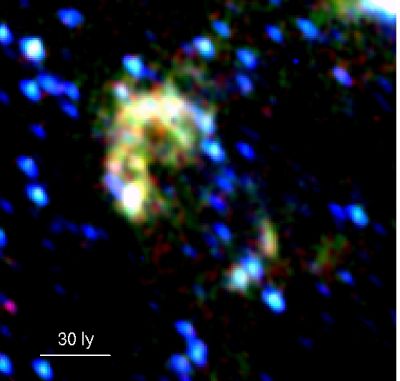AKARI Results
The first infrared detection of a supernova remnant in the Small Magellanic Cloud
AKARI detected for the first time, a supernova remnant in our neighbouring galaxy, the Small Magellanic Cloud in the infrared wavelength from 3 to 11 micrometres, and investigated the interaction between the supernova remnant and the interstellar material.
The Small Magellanic Cloud is a small galaxy neighbouring our own Milky Way Galaxy at a distance of 200 000 light years, visible from the southern hemisphere. AKARI detected the supernova remnant B0104-72.3 in this galaxy for the first time at the infrared wavelengths of 3, 4, 7 and 11 micrometres with the Near- and Mid-Infrared Camera (IRC) onboard AKARI. This was the very first infrared observation of a supernova remnant in the Small Magellanic Cloud. Figure 1 shows the colour composite image of the supernova remnant B0404-72.3. A pair of arc-like structures in the middle of the image can be clearly seen. This is the spatial extent of the supernova remnant and covers approximately 60x100 light years.

Figure 1: Three colour composite image of the supernova remnant B0104-72.3 in the Small Magellanic Cloud by the Near- and Mid-Infrared Camera onboard AKARI (Blue: 4 micrometres, Green: 7 micrometres, Red: 11 micrometres). The pair of arcs in the central part of the image is the supernova remnant extended over a region of 60x100 light years. The white bar in the bottom-left corner indicates a length of 30 light years.
After a supernova explosion at the end of a massive stars life, the matter ejected from the star expands into interstellar space, becoming what is known as a supernova remnant. This is the final stage in the life of stars much heavier than our own Sun. Supernovae provide newly synthesized elements created inside the star's core into interstellar space. More over the catastrophic explosion of the star also disturbs the interstellar material creating shock waves over great distances. The contribution of supernova, via these mechanisms, is an essential component in the evolution of our own and other galaxies. Infrared observations are important in that they trace the interaction between the supernova remnant and the interstellar medium. However, until recently the lack of accumulated data to date has limited our understanding of the detailed processes of this interaction. The infrared radiation observed by AKARI is thought to originate from the shell at the border of the interaction between the expanding gas from the supernova explosion and the surrounding interstellar material. AKARI observed the supernova remnant at four different infrared wavelengths. The intensity ratios between the data reveal the presence of a shock at the interaction between the expanding supernova remnant and the surrounding molecular clouds. This result implies that the precursor of this supernova remnant was a high mass star.
B0104-72.3 is a well-known supernova remnant that has been observed with radio and X-rays, although it is not a particularly bright object at these wavelengths. Observations with AKARI are expected to play a key role in understanding the evolution of the interstellar material via studies of interaction processes with the supernova remnant. AKARI is observing many supernova remnants for this purpose.
This study is carried out by the research group lead by Prof. Bon-Chul Koo in Seoul National University, Korea.
Materials
- Figure 1 (© ISAS/JAXA)





